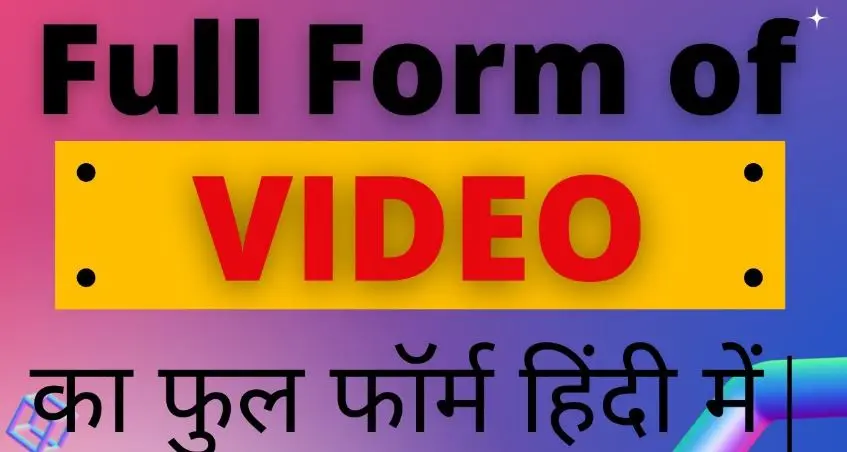VIDEO Ka Full Form! Where visual content dominates the online landscape, the term “VIDEO” has become an integral part of our daily communication and entertainment experiences. Originating from the Latin word “videre,” meaning “to see,” the acronym “VIDEO” encapsulates the essence of visual storytelling and communication in a succinct manner.
Standing for “Visual Information Displayed Electronically Online,” VIDEO embodies the convergence of technology and creativity, allowing individuals and organizations to convey messages, share experiences, and entertain audiences through moving images and sound. Whether it’s a captivating short film, an informative tutorial, a lively vlog, or a viral meme, videos have the power to engage, inspire, and evoke emotions like no other medium.
The evolution of digital platforms and the widespread availability of high-speed internet have democratized the creation and consumption of videos, empowering content creators and viewers alike. From streaming services delivering on-demand entertainment to social media platforms fostering community through user-generated content, the impact of videos transcends geographical boundaries and cultural barriers.
What does VIDEO stand for?
“VIDEO” stands for “Visual Display Unit Input/output.” Each word in this acronym carries significance:
-
Visual: Refers to anything related to sight or vision. In the context of video, it pertains to the visual component of the medium, which involves the representation of images or scenes.
-
Display Unit: Refers to a device or equipment that presents visual information. This can include screens, monitors, or any other display mechanism that showcases visual content.
-
Input/Output: Denotes the interaction between the device and external sources or users. In the case of video, “input” refers to the process of feeding visual information into the system, such as recording or importing video footage. “Output” refers to the result of the processed visual information, which could be displayed on a screen or transmitted to an external device.
Together, “Visual Display Unit Input/output” encapsulates the essence of video technology, emphasizing its role in capturing, processing, and presenting visual information for various purposes such as entertainment, communication, education, and more.
VIDEO Ka Full Form in English
“VIDEO” stands for “Visual Display Unit Input/output,” constituting a digital medium pivotal for capturing, processing, transmitting, and reproducing visual data. Its creation typically involves capturing moving images through devices like cameras, smartphones, or specialized recorders. Videos serve diverse purposes ranging from entertainment and education to communication and documentation, permeating various aspects of our daily routines. Indeed, they have evolved into an indispensable component of modern life, with an array of platforms and formats facilitating seamless sharing and viewing experiences.
Visit Now: LPA Full Form in Hindi and English
VIDEO Ka Full Form in Hindi
“वीडियो” का पूरा रूप “विशेषण द्वारा दृश्य और श्रृंगार का चित्रण” होता है, जिसका अर्थ है कि इसमें विजुअल और ध्वनि संगीत की प्रतिमा उपस्थित होती है। वीडियो फ़ीड के रूप में, इसे देखा जा सकता है और इसका प्रयोग संचार, मनोरंजन और शिक्षा जैसे विभिन्न क्षेत्रों में किया जाता है। इस विशेषण की मुख्यता यह होती है कि यहां दर्शकों को एक दृश्य और ध्वनि संगीत की प्रतिमा प्रस्तुत की जाती है, ताकि वे पूरी कहानी को समझ सकें और उसमें सहयोग कर सकें।
Frequently Asked Questions
What is the full form of VIDEO?
The full form of VIDEO is “Visual Display Unit Input/output” or “विशेषण द्वारा दृश्य और श्रृंगार का चित्रण” in Hindi.
How is VIDEO used?
VIDEO is a digital medium utilized for capturing, recording, processing, transmitting, and reproducing visual information. It is commonly created using devices like cameras, smartphones, or professional video recorders.
What are the purposes of VIDEO?
Videos serve various purposes including entertainment, education, communication, documentation, marketing, and more. They are used across industries and sectors to convey messages, share experiences, and engage audiences.
What are the common formats for sharing videos?
Common formats for sharing videos include MP4, AVI, MOV, WMV, and MKV among others. These formats are compatible with different devices and platforms for easy sharing and viewing.
How has VIDEO impacted society?
VIDEO has revolutionized how we consume information, entertainment, and communicate with one another. It has democratized content creation, provided new avenues for expression, and facilitated global connectivity through platforms like social media and streaming services.
Are there any legal considerations when using VIDEO?
Yes, there are legal considerations such as copyright laws, privacy concerns, and regulations regarding content distribution and licensing. It’s important to respect intellectual property rights and adhere to legal guidelines when creating and sharing videos.
Conclusion
Understanding the full form of VIDEO, whether in English as “Visual Display Unit Input/output” or in Hindi as “विशेषण द्वारा दृश्य और श्रृंगार का चित्रण,” sheds light on the fundamental nature of this digital medium. VIDEO encompasses a vast array of functions, from capturing moments to transmitting information, and from entertaining audiences to educating viewers. Its impact on society is profound, shaping how we communicate, learn, and interact with the world around us.
As technology continues to evolve, VIDEO remains at the forefront of innovation, offering endless possibilities for creativity and expression. Whether it’s through social media platforms, streaming services, or educational resources, VIDEO continues to bridge gaps, foster connections, and enrich lives worldwide. Embracing its full potential requires not only technical proficiency but also ethical responsibility, ensuring that its power is wielded responsibly and respectfully. Ultimately, VIDEO stands as a testament to humanity’s ability to harness technology for the greater good, captivating hearts and minds with its visual storytelling prowess.
